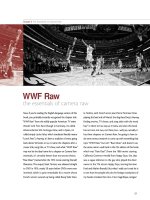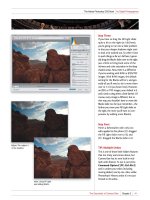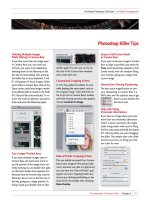The Adobe Photoshop CS5 Book for Digital Photographers part 8 ppsx
Bạn đang xem bản rút gọn của tài liệu. Xem và tải ngay bản đầy đủ của tài liệu tại đây (1.66 MB, 10 trang )
ptg
Deleting Multiple Images
While Editing in Camera Raw
If you have more than one image open
in Camera Raw, you can mark any
of them you want to be deleted by
selecting them (in the filmstrip on the
left side of Camera Raw), then pressing
the Delete key on your keyboard. A red
“X” will appear on those images. When
you’re done in Camera Raw, click on the
Done button, and those images marked
to be deleted will be moved to the Trash
(PC: Recycle Bin) automatically. To re-
move the mark for deletion, just select
them and press the Delete key again.
Get a Larger Preview Area
If you have multiple images open in
Camera Raw, and need more room to
see the preview of the image you’re cur-
rently working on, just double-click right
on that little divider that separates the
filmstrip from the Preview area, and the
filmstrip tucks in over to the left, out of
the way, giving you a larger preview. To
bring it back, just double-click on that
divider again (it’s now over on the far
left side of the Camera Raw window)
and it pops back out.
Constrained Cropping Is Here
In CS5, they added the ability to crop
while keeping the same aspect ratio as
the original image. Click-and-hold on
the Crop tool in Camera Raw’s toolbar,
and from the pop-up menu that appears,
choose Constrain to Image.
Rule-of-Thirds Cropping Is Here
This one Adobe borrowed from Camera
Raw’s sister program Photoshop Light-
room, because now (like in Lightroom),
you can have the “Rule-of-Thirds” grid
appear over your cropping border any-
time by just clicking-and-holding on the
Crop tool in the toolbar, then choosing
Show Overlay.
Jump to Full Screen Mode
in Camera Raw
If you want to see your image in Camera
Raw as large as possible, just press the
F key, and Camera Raw expands to Full
Screen mode, with the window filling
your monitor, giving you a larger look
at your image.
Shortcut for Viewing Sharpening
The best zoom magnification to view
your sharpening in Camera Raw is a
100% view, and the quickest way to get
there is to just double-click
the Zoom tool.
Help with Fixing
Chromatic Aberrations
If you have an image where you have
more than one chromatic aberration
(which is quite common), this might
make things easier: when you’re fixing
the first color, press-and-hold the Option
(PC: Alt) key before you start dragging
the slider. This isolates that color slider,
and lets you focus on fixing just that
one color for now.
51Chapter 2The Essentials of Camera Raw
The Adobe Photoshop CS5 Book for Digital Photographers
Photoshop Killer Tips
Download from www.wowebook.com
ptg
Photo by Scott Kelby Exposure: 1/400 sec | Focal Length: 20mm | Aperture Value: ƒ/8
Download from www.wowebook.com
ptg
Chapter 3 Camera Raw—Beyond the Basics
53
When I searched The Internet Movie Database (IMDb)
for movies or TV shows containing the word “Raw,” I was
pleasantly surprised to find out just how many choices I
actually had. However, I went with the 1994 movie Raw
Justice, but I don’t want you to think for one minute that
I was influenced in any way by the fact that the star of the
movie was Pamela Anderson. That would be incredibly
shallow of me. Like any serious movie buff, I was drawn
to this movie by what drew most of the audience to this
movie: actor Robert Hays (who could forget his role in
2007’s Nicky’s Birthday Camera or the Michael Tuchner–
directed film Trenchcoat). Of course, the fact that Stacey
Keach was in the movie was just the icing on the cake, but
everybody knows the real draw of this flick clearly was
Hays. However, what I found most puzzling was this: in
the movie poster, Pamela Anderson totally dominates the
poster with a large, full-color, ¾-length pose of her wear-
ing a skimpy black dress, thigh-high boots, and holding
a pistol at her side, but yet the other actors appear only
as tiny black-and-white, backscreened headshots. I have
to admit, this really puzzles me, because while Pamela
Anderson is a fine actress—one of the best, in fact—I feel,
on some level, they were trying to fool you into watching
a movie thinking it was about Pamela Anderson’s acting,
when in fact it was really about the acting eye candy that
is Hays. This is called “bait and switch” (though you prob-
ably are more familiar with the terms “tuck and roll” or
perhaps “Bartles & Jaymes”). Anyway, I think, while “Raw
Justice” makes a great title for a chapter on going beyond
the basics of Camera Raw, there is no real justice in that
this finely crafted classic of modern cinematography
wound up going straight to DVD.
Raw Justice
camera raw—beyond the basics
Download from www.wowebook.com
ptg
54
Chapter 3 Camera Raw—Beyond the Basics
The Adobe Photoshop CS5 Book for Digital Photographers
Step One:
Open the photo you want to double-
process. In this example, the camera
properly exposed for the foreground,
so the sky is totally blown out. Of
course, or goal is to create something
our camera can’t—a photo where both
the inside and outside are exposed
properly. To make things easy, we’re
going to open this image as a Smart
Object in Photoshop, so press-and-hold
the Shift key, and the Open Image but-
ton at the bottom changes into the
Open Object button. Click that button
to open this version of the photo in
Photoshop as a Smart Object (you’ll see
the advantage of this in just a minute).
As good as digital cameras have become these days, when it comes to exposure,
the human eye totally kicks their butt. That’s why we shoot so many photos where
our subject is backlit, because with our naked eye we can see the subject just fine
(our eye adjusts). But when we open the photo, the subject is basically in silhouette.
Or how about sunsets, where we have to choose which part of the scene to expose
for—the ground or the sky—because our camera can’t expose for both? Well, here’s
how to use Camera Raw to overcome this exposure limitation:
Double-Processing
to Create the
Uncapturable
SCOTT KELBY
Download from www.wowebook.com
ptg
55Chapter 3Camera Raw—Beyond the Basics
Continued
The Adobe Photoshop CS5 Book for Digital Photographers
Step Two:
Your image will open in Photoshop
as a Smart Object (you’ll see the layer
thumbnail has a little page icon in the
bottom-right corner). So, now we need
a second version of this image—one
we can expose for the sky. If you just
duplicate the layer, it won’t work,
because this duplicate layer will be tied
to the original layer, and any changes
you make to this duplicate will also be
applied to the original layer. So, to get
around that, go to the Layers panel, Right -
click on the layer, and from the pop-up
menu that appears, choose New Smart
Object via Copy. This gives you a dupli-
cate layer, but breaks the link.
Step Three:
Now double-click directly on this dupli-
cate layer’s thumbnail and it opens this
duplicate in Camera Raw. Here, you’re
going to expose for the sky, without any
regard for how the foreground looks
(it will turn really dark, but who cares—
you’ve already got a version with it prop-
erly exposed on its own separate layer). So,
drag the Exposure slider way over to the
left, until the sky looks properly exposed
(I also increased the Recovery, Blacks, and
Vibrance settings). Now, click OK.
Download from www.wowebook.com
ptg
56
Chapter 3 Camera Raw—Beyond the Basics
The Adobe Photoshop CS5 Book for Digital Photographers
Step Four:
You now have two versions of your
photo (as seen here), each on different
layers—the brighter one exposed for the
foreground on the bottom layer, and the
darker version on the layer directly on
top of it, and they are perfectly aligned,
one on top of the other.
TIP: Always Opening Your Images
as Smart Objects
If you always want your RAW-processed
images to open as Smart Objects, click
on the workflow options link at the bot-
tom of the Camera Raw dialog (the blue
text below the Preview area), and when
the dialog appears, turn on the Open in
Photoshop as Smart Objects checkbox.
Download from www.wowebook.com
ptg
57Chapter 3Camera Raw—Beyond the Basics
The Adobe Photoshop CS5 Book for Digital Photographers
Step Five:
Next, we’ll blend these two images using
a layer mask. Go to the Layers panel,
press-and-hold the Option (PC: Alt) key,
and click on the Add Layer Mask icon
at the bottom of the panel. This puts a
black mask over the layer with the photo
exposed for the sky, covering it so you
only see the lighter image on the back-
ground layer (as seen here). Now, press the
letter B to get the Brush tool, then click
on the Brush icon in the Options Bar and
choose a medium-sized, hard-edged brush
from the Brush Picker (this helps to keep
you from painting outside the lines). Press
the letter D to set your Foreground color
to white, and start painting over the
areas of the photo that you want to be
darker (in this case, the sky). As you paint
with white directly on that black mask,
the white reveals the darker version
beneath the mask. Below is a before/
after of the image.
Before After
Download from www.wowebook.com
ptg
58
Chapter 3 Camera Raw—Beyond the Basics
The Adobe Photoshop CS5 Book for Digital Photographers
Step One:
The key to making this work is that the
photos you edit all are shot in similar
lighting conditions, or all have some
similar problem. In this case, our photos
are from an indoor basketball game, and
there’s a green color cast to them from
the lighting on the court. In Mini Bridge,
start by selecting the images you want
to edit (click on one, press-and-hold the
Command [PC: Ctrl] key, then click on all
the others). If they’re RAW images, just
double-click on any one of them and they
open in Camera Raw, but if they’re JPEG
or TIFF images, you’ll need to select them,
then switch to Review mode, and then
press Option-R (PC: Alt-R).
Step Two:
When the images open in Camera Raw,
you’ll see a filmstrip along the left side
of the window with all the images you
selected. Now, there are two ways to
do this and, while neither one is wrong,
I think the second method is faster
(which you’ll see in a moment). We’ll
start with the first: Click on an image in
the filmstrip, then make any adjustments
you want to make this one image look
good (I tweaked the white balance so
it wasn’t so green).
One of the biggest advantages of using Camera Raw is that it enables you
to apply changes to one photo, and then easily apply those exact same
changes to a bunch of other similar photos taken in the same approximate
setting. It’s a form of built-in automation, and it can save you an incredible
amount of time when editing your shoots.
Editing Multiple
Photos at Once
SCOTT KELBY
Download from www.wowebook.com
ptg
59Chapter 3Camera Raw—Beyond the Basics
Continued
The Adobe Photoshop CS5 Book for Digital Photographers
Step Three:
Once you’ve got one of the photos looking
good, click the Select All button up at the
top of the filmstrip to select all the photos
(even though it selects the rest of the pho-
tos, you’ll notice that the image you edited
is actually the “most selected” image, with
a highlight border around it). Now click
the Synchronize button (it’s right below
the Select All button) to bring up the
Synchronize dialog (seen here). It shows
you a list of all the things you could copy
from this “most selected” photo and apply
to the rest of the selected photos. Choose
White Balance from the pop-up menu
at the top, and it unchecks all the other
stuff, and leaves just the White Balance
checkbox turned on.
Step Four:
When you click the OK button, it applies
the White Balance settings from the “most
selected” photo to all the rest of the select-
ed photos (if you look in the filmstrip, you’ll
see that all the photos have had their white
balance adjusted). Okay, so why don’t I
like this method? Although it does work,
it takes too many clicks, and decisions,
and checkboxes, which is why I prefer the
second method.
TIP: Editing Only Select Photos
If you only want certain photos to be
affected, and not all the ones open
in Camera Raw, then in the filmstrip,
Command-click (PC: Ctrl-click) on only
the photos you want affected and click
the Synchronize button.
Download from www.wowebook.com
ptg
60
Chapter 3 Camera Raw—Beyond the Basics
The Adobe Photoshop CS5 Book for Digital Photographers
Step Five:
In the second method, as soon as Camera
Raw opens, click the Select All button
to select all your images, then go ahead
and make your changes. As you make the
changes to your “most selected” photo,
all the others are updated with your new
settings almost instantly, so you don’t
have to remember which settings you
applied—when you move one slider, all
the images get the same treatment, so
you don’t need the Synchronize dialog
at all. Try out both methods and see
which one you like, but if you feel the
need for speed, you’ll probably like the
second one much better.
Download from www.wowebook.com









